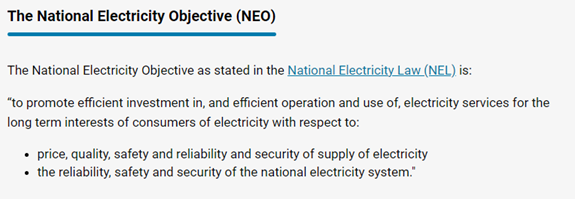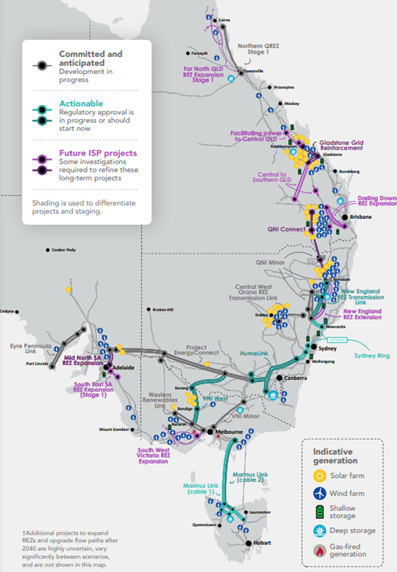National Energy Partnership – we have lift off
When most of us plan a trip overseas we often don’t give much thought to how the pilot will get there. It is much more enjoyable to think about cocktails in the sun, rather than what flight path the plane will take. Those sorts of details are probably best left to the pilot and air traffic control. Specially trained, they have an overall view of the skies, what planes are landing where and when and what capacity the airport has to land the planes and allow holiday makers to disembark.
The energy transition is much the same. While the average person is concerned about climate change and Australia’s destination to net zero, the how is best left to governments, market bodies and energy businesses.
Most sensible people seem to accept these days that Australia’s transition to a renewable energy future is essential. Exactly how we get there is the subject of much debate – which is why last week’s Energy Ministers’ Meeting was so important.
So, fasten your seat belts and keep your chairs upright, we are about to take a nose dive into the communique from the Energy Minister Meeting and what that might mean for energy customers and the sector.
View from the top
Shortly after the election of the Labor Government and the appointment of Chris Bowen as the Federal Energy Minister in May, Australia was hit with an energy crisis due to a range of factors that put energy security and power prices firmly back on the political agenda. Bowen made quick moves to call an energy market crisis meeting and bring the states and territories together to discuss next steps to address the dual issues of unprecedentedly high wholesale prices, and supply shortages that threatened not only widespread customer outages but broader system security.
The Energy Ministers’ Meeting (EMM) last week was the first time the ministers had met since then. This marathon six-hour meeting has been reported as the most collegiate in many years and has sought to grab the yoke of the energy transition and set the direction of states and territories working together.
National Energy Transformation Partnership
Australia, we know, is unique in many ways. We are fortunate in our abundant resources and self-reliance for energy supply. Unlike countries like Ukraine and Europe generally, we are not dependent on energy imports to keep our lights on, our homes warm and fuel industry. This makes it particularly important to ensure we are all reading from the same flight manifest when deciding the direction to take on our energy journey.
After many years of policy discord between state and federal levels, a new era has dawned. Energy Ministers, under the new chairmanship of Minister Bowen, have agreed to ‘the vision, principles and key initial priority areas for a new National Energy Transformation Partnership (NETP)’ which ‘represents a fundamental reset of relations across governments and the first fully integrated national energy and emissions agreement.’
A key first outcome from the partnership is integrating emissions into the National Electricity Objective (NEO)[1], National Gas Objective and National Energy Retailer Objective.
The national energy objectives focus on the long-term interests of customers with factors like prices, safety and reliability but they previously have not included an emissions reduction objective. By including this, governments, market bodies and other market participants will be required to consider emissions reductions within the policy frameworks. It is also a strong investment signal for renewables and technologies to support their integration with the grid.
Including emissions in the National Gas Objective (NGO), which is centred around the use of natural gas, could support the continued development of biomethane and hydrogen – and would be further enhanced by the introduction of a national renewable gas target.
Transmission of national significance
Transmission infrastructure is critical to enable Australia’s transition to renewable energy –while ensuring secure, reliable, affordable, and sustainable energy for consumers. The Australian Energy Market Operator’s 2022 Integrated System Plan identifies an additional 10,000kms of transmission lines are required to support 120 GW of large scale renewable energy and storage on the national interconnected energy system.
It’s no easy feat, but there’s no transition without transmission. A recent report from Energy Networks Australia and the Clean Energy Council highlighted this critical need and some of the barriers to delivering it.
Stakeholders interviewed for the report supported the twin objectives of delivering infrastructure projects at the least cost to customers and ensuring transmission projects are financeable and able to be built when they are needed, within a supportive policy framework.
One of the objectives of the NETP will be to ‘identify and declare transmission of national significance.’
These projects will include those highlighted in the ISP – including Marinus link, VNI West, and Humelink – to accelerate the timely delivery of these critical projects and ensure better community engagement.
This satisfies the second objective of delivering infrastructure projects when they are needed. This new approach is intended to overcome challenges posed by the existing cumbersome regulatory framework.
Few would agree that the current Regulatory Investment Test for Transmission (RIT-T) required by the Australian Energy Regulator is fit for purpose to support the transmission development required and facilitate genuine engagement and community benefit. However, there is a word of warning here to not throw the baby out with the bathwater. In this case the baby is good, transparent decision making.
Rigour and transparency needs to be maintained throughout the decision-making process to ensure transmission development is in the long-term interests of customers.
When we fail to plan…
As Australia’s power and gas grids become smarter, more integrated, and more efficient they play a critical role in delivering the clean energy transition. Without these platforms working together, our economy cannot decarbonise. All network types – transmission, distribution and gas – are transforming to accommodate a clean energy future. The energy sector will need to move earlier than most, accelerating pathways for other sectors, such as transport, to decarbonise.
The energy ministers committed to ‘develop detailed integrated energy infrastructure and regional planning scenarios that span gas and electricity networks, electrification pathways and new industry possibilities to identify jobs and investment pathways for renewed manufacturing and new industries, like hydrogen.’
Energy Networks Australia (ENA) has worked with networks, consumer groups and energy market bodies to develop a vision that describes how the three network types can work together and with customers to forge a collective pathway to net zero.
Networks have a vital role to play in facilitating and supporting demand side participation as customers change the way they interact with the energy grid as it becomes smarter and more integrated.
Implementation of Post-2025 reforms
In late 2021, the Energy Security Board (ESB) released a suite of reforms to meet the needs of the energy transition in the immediate, short and long term. These included the controversial capacity mechanism and congestion management.
In recognition of the divergence of views around the form a capacity mechanism might take, ministers agreed to take it out of the ESB’s remit. Senior officials from the jurisdictions will now be responsible for delivering the capacity mechanism under the leadership of Ministers.
Having freed up some resources, the ESB has instead been asked to expedite its work on congestion management and report back to the next meeting.
Gas Market Reforms
Gas market reforms largely focus on upstream and downstream natural gas supply.
However, given the proposed inclusion of emissions in the national energy objectives and recognition of the critical role of energy networks to decarbonisation, there is scope for a conversation about a national renewable gas target. This would support the decarbonisation of the gas system and a long-term role for the sector to complement increasing amounts of renewable electricity and the development of a competitive hydrogen market.
Another of the reforms in the gas space includes the Australian Energy Market development of Operator’s an annual Winter Readiness Management Plan for east coast energy markets and incorporation of gas supply and system adequacy risks into their annual Summer Readiness Plan. This will enable security and reliability risks to be identified early and considered in both electricity and gas markets. This type of preparation is key as the effects of climate change deliver harsher and more extreme temperatures during summer and winter.
Governance
A rigorous governance program should be a help, not a hinderance. It should allow a process to continue fairly and within the confines of the law, but not be a barrier to innovation or success.
Former ASIC Chairman James Shipton was quoted in the Australian on 15 August about the virtue of statements of expectations for regulatory agencies. “Having no statement of expectations is equivalent to Qantas asking a pilot to fly a plane without providing the destination. Running a regulatory agency should not be a mystery flight.” He’s right – and in this vein, it was good to see that the energy ministers meeting approved new, long-awaited Statements of Expectations for the Australian Energy Market Commission and Australian Energy Regulator and a Statement of Role for AEMO.
This is something several major reviews have recommended over a number of years and a reform ENA has promoted. While it is very welcome, it was disappointing no consultation with industry was undertaken in the development of the statements and we have yet to see what they contain.
The new Government and its energy minister have taken a firm hand on the reins of national energy policy. There has been a most welcome move to transparency of outcomes and engagement with industry from the national energy ministers’ meeting process. Most importantly, at a time when we need to move to a more connected energy system and greater consistency of approach, it is a relief to see political decision makers working collegiately after a long period of discord.
[1] https://www.aemc.gov.au/regulation/neo




